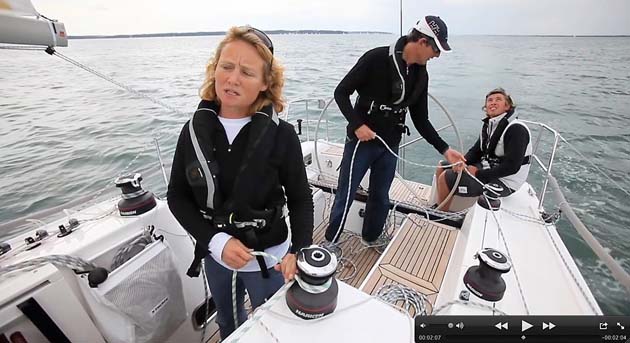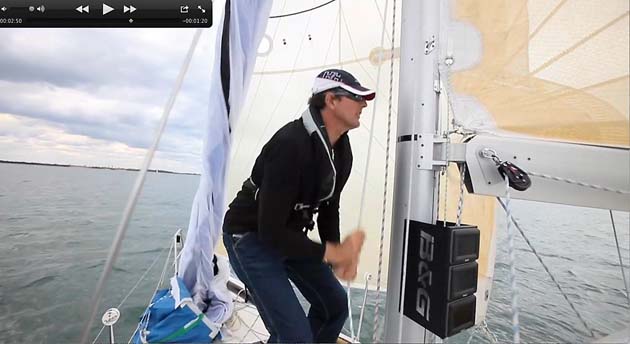It’s the cause of many a club-bar yarn and fills many yachtsmen with dread. Yet in Part 10 of our series on advanced sailing techniques Pip Hare says the spinnaker hoist can be simple
![]()
The basic principles of hoisting a spinnaker are easy to grasp. More importantly, they are the same whether you are sailing fully crewed, short- or single-handed and use an asymmetric or a symmetric spinnaker – get it to the top of the mast in one go and without twists.
The secret to a successful hoist is to break the manoeuvre down – that way you can understand the constituent parts and the order in which each should happen. Through this technique I have taught total novices to hoist successfully and also manage large spinnakers single-handed.
Preparation
Take your time to prepare for the hoist: clear winches, set your pole height, make sure your sheet will be free to run and the tweakers are off. Double-check that the halyards, sheets and guys are not twisted.
A good briefing to your crew or a mental run-through if alone is essential to success; plan each part of the hoist in sequence and make sure there is only one person conducting the orchestra.
See our video of SAIL FASTER SAIL SAFER Part 10
Hoist a symmetric kite
This is usually best done behind the jib, which will act as a windbreak, prevent a forestay wrap and give you more of a chance to get the spinnaker up before it fills. Oversheet the jib to give the spinnaker a more direct route to the top of the mast.
Steer a safe downwind course, reducing the apparent wind. If you are using the pilot, set it up in compass mode, with the response levels high enough to cope with any waves. Be prepared to wait for a minute after engaging it just to make sure that any swell is not knocking you off course.
Pull on the guy, until the pole is about a metre off the forestay; this helps to prevent wraps by keeping the two clews apart. But be aware that if you pull it too far around, the spinnaker will be exposed to the wind and could fill before you get the head to the top.
Hoist from the mast, with someone tailing in the cockpit. If you do a lot of short-handed sailing it’s a good idea to put
a small cleat on the mast to take the load of the halyard once hoisted while you tail it through to the jammer aft.
If you have enough crew, start to bring
on the guy during the hoist, so that the sail comes out from behind the jib and at the correct angle of trim.
Once the spinnaker is hoisted, sheet on. If racing you can consider sheeting on mid-hoist, but make sure someone is willing to wind up the last few feet of halyard – it’s much tougher! Easing the tweakers will help to spill wind from the sail if needed.
The jib as a windbreak:

Sheet on once hoisted:

Hoist at the mast for speed:

Hoist an asymmetric
The same rules as for the symmetric spinnaker apply; take your time to set up the hoist and ensure your tackline is completely free when you pull out a retractable bowsprit, so it does not take the spinnaker out with it. When ready for the hoist, pull on the tack line, then the halyard then the sheet.
Tidy up
Finally once the spinnaker is set, put away your jib and tidy the cockpit. Always make sure your halyard and windward sheets and guys are flaked and ready for
a quick drop.
Snuffers
Snuffers make the job of hoisting a spinnaker easier. The compromise is they mean you lose a little sail area from the head of the sail and have more weight at the top of the rig. Snuffers are easiest to operate from a clear foredeck, so to avoid a tangle put away the jib and give yourself some space.
Again, take time to prepare: get your pole set up or your tack clipped on if you are flying a cruising chute from a fixed point on the bow. Snuffer lines have a habit of tangling while they are in the bag, so lay out the line on deck and ensure that the snuffer line will end up on same side as you when you attach the sheets, guys or tacklines.
Hoist the snuffer first, then pull on the tack line or the guy. Be careful in breezier conditions as this could allow wind to funnel up the snuffer and start your hoist early.
Before raising the sock it is sometimes a good idea to reach all the way inside the snuffer and pull down on the spinnaker to make sure it is not bunched up in the first third of the sock – this is where most of the spinnaker lies. With this done, once the tack or guy are pulled out, pull on the sheet a little, so the spinnaker will fill gently as the snuffer goes up rather than just flap.
Ensure you pull the bucket right up to expose the head of the spinnaker – it is easy to miss this last little bit – then tie it off to an easily accessible place on the deck so that you are ready to drop quickly.
Using a snuffer:

How the experts do it
Here’s a neat trick used by professional solo sailors – mark everything to make hoisting easier. By marking the guys and sheets at the perfect position for the hoist, you can pre-set them and be sure you get it right every time. This is also true of halyards because it lets you focus on the rope while you are hoisting and not stop until the sail has reached the mast head; it is easy to miss the last metre of the hoist, especially at night, thereby sacrificing speed and making the sail less stable. Hoisting to a mark will mean you get it right every time.
Top tips
- If flying a spinnaker short-handed it is a good idea to ‘wool’ the spinnaker before each hoist in order to be sure that it does not fill too early.
- If you do not want to wool the whole spinnaker then just do the first couple of metres of the leading corner. Keeping the tack or the windward clew bound will allow you to pull the leading edge of the sail out and as a result be confident that it will not start filling. This tip also works well with snuffers.
- If the spinnaker does twist as it is hoisted, don’t panic! Try spreading the clews by pulling the pole back and sheeting on. If the twist is high up in the sail, ease the halyard about a metre. This moves the head of the sail away from the mast and gives it room to rotate. The twist sometimes works its own way out.
 Single-handed ocean sailor Pip Hare has clocked up thousands of miles racing and cruising. Among her achievements are five solo transatlantics, including the OSTAR and two Mini Transat races. She also works full-time for the RNLI on sea safety and is Consulting Editor on Yachting World. See also her series on short-handed sailing
Single-handed ocean sailor Pip Hare has clocked up thousands of miles racing and cruising. Among her achievements are five solo transatlantics, including the OSTAR and two Mini Transat races. She also works full-time for the RNLI on sea safety and is Consulting Editor on Yachting World. See also her series on short-handed sailing
SAIL FASTER SAIL SAFER Part 11: Pip Hare examines the delicate art of dropping the spinnaker
12 part series in association with Pantaenius




